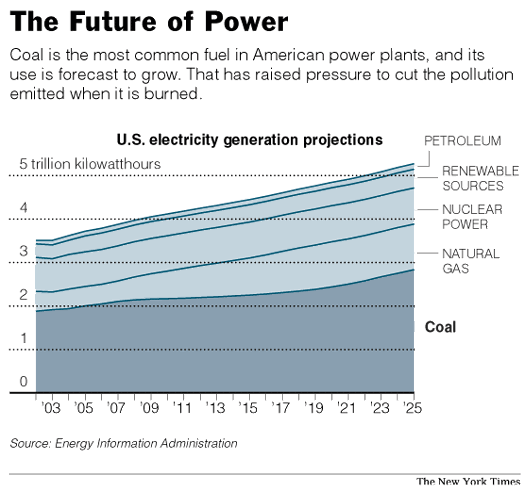The following article ran in the NY Times on Sunday, Dirty Secret: Coal Plants Could Be Much Cleaner by Kenneth J. Stier. It's interesting for the simple reason that the burning of coal presently makes up over 50% of our energy production for electricity in this country, a percentage that's more apt to increase than decline, and Stier tells us about a technology that could go a long way towards making this fuel more environmentally friendly.
Coal is so abundant in the U.S. that we actually are able to export it. I recall reading somewhere that our current reserves of coal should be able to last us for the next 200 to 300 years. Clearly coal is no small thing in this country. There are problems with coal, as many of us are well aware, but let me detail some of them:
1. The burning of coal releases more radioactivity in the environment than a nuclear power plant. Turns out you have a small but measurable amount of radioactive material in coal and when burnt it's sent into the environment. While nuclear power plants potentially threaten to release huge amounts of radiation into the environment if their containment systems are breached, safely run nuclear plants release very little radiation into the surrounding environment at all. [I suspect that some may find this surprising, so I refer you to Coal Combustion, a publication put out by the Oak Ridge National Laboratory --- yes, a government site --- where we're told:
Former ORNL researchers J. P. McBride, R. E. Moore, J. P. Witherspoon, and R. E. Blanco made this point in their article "Radiological Impact of Airborne Effluents of Coal and Nuclear Plants" in the December 8, 1978, issue of Science magazine. They concluded that Americans living near coal-fired power plants are exposed to higher radiation doses than those living near nuclear power plants that meet government regulations. This ironic situation remains true today and is addressed in this article.
Wow, wonders of wonder, huh?]
2. Getting the coal out of the ground is problematic. People potentially die (though I'd much rather be a coalminer in the U.S. than in China), and the local environment is often dirtied by coal digging and its byproducts, or the very destructive process of strip mining.
3. Burning coal is responsible for a large part of the mercury in the environment, specifically in our water. Today today children and pregnant women are warned by the government [mind you, if you visit this site you're blithely informed by the FDA that "...nearly all fish and shellfish contain traces of mercury.", like it's something we should normally expect to see and just take for granted --- there's something wrong with this picture] to limit their ingestion of fish to no more than one serving per week because of the mercury levels found in fish.
4. Acid rain is due to pollutants associated with coal and petroleum fired power plants, though you can clearly see which of these two make the great contribution. This, and the equally serious consideration of the amount of carbon dioxide these plants generate, make coal VERY unattractive as an environmentally friendly fuel source.
The article talks about a technology, called "integrated gasification combined cycle" (henceforth IGCC here), which isn't new, that allows coal to be burned but producing significantly less pollution than the standard coal-burning plants currently online. These plants are 10% more efficient, use 40% less water, the technology allows for the stripping out of about 50% of the sulfur dioxide and nitrogen oxides which cause acid rain and smog, and 95% of the mercury in coal all before combustion at a tenth of the cost of what it takes to scrub smokestack emissions as they leave the power plant. Moreover, and a very attractive feature to this technology, is that it allows for the capture of carbon prior to combustion, i.e. it significantly reduces the release of carbon dioxide into our atmosphere. All of this doesn't entirely make these plants "green", but it is a very significant step in the right direction for a fuel source that we're not in a position to simply ignore given its abundance and the relative ease with which we're able to obtain it.
IGCC would seem to be a no-brainer in terms of where we should be going with coal, right? So what would be the major hold up? Well to start such plants cost about 20% more than standard plants to build, so the short-term financial outlay for them is greater and sometimes that by itself can make the difference between a plant being built or not. The one strong advantage with
these plants is the ability to sequester carbon, reducing our contribution to the carbon we put into the air --- I won't get into how this may help induce global warming, I would prefer to keep this at the level of it logically making sense that if we keep doing this it can't be good for the environment at some point in the future (those of us currently going through a very cold and wet late spring in New England would tend to say the future is now.) But we don't regulate carbon in this country, in fact Congress has specifically avoided anything to do with such regulation given how unpopular it is with the energy industry and any other industry (read "auto" industry) that could be affected by regulating carbon emissions.
Here's where the industry falls out on this (this is taken from the article):
REGARDLESS of the politics of carbon caps, the Energy Department has made it clear that it intends to push the development of integrated gasification combined-cycle technology. Last month, for example, Mark Maddox, a deputy
assistant secretary, said at an industry gathering that the technology "is needed in the mix - needed now."
Some industry leaders are skeptical, to say the least. "We would not want to put all of our eggs in one basket as far as a single technology is concerned," said William Fang, deputy counsel for the Edison Electric Institute, a trade association whose members, shareholder-owned utilities, account for three-quarters of the country's generating capacity.
Besides, he added, many of his members think that mandatory carbon controls, in place in much of the world since the Kyoto Protocol came into force in February, can be kept at bay in the United States - possibly indefinitely [emphasis by blogger].
So basically those who make money off of coal are pushing to make sure we never buy into carbon caps in this country, and that we don't employ the technology that's available to us to minimize the pollutants associated with this unavoidable fuel source.
More tomorrow (promise, I already wrote it.)


2 Comments:
Very interesting stuff, James. I'm certainly for using the energy resources we do have and improving the way the use of those fuels impacts the environment. One thing that just recently came to my attention, however, is that traditional strip mining isn't the worst example of the extraction process. Enter mountaintop removal. It's just one more factor to enter into the equation, I suppose. And maybe we don't really need those extra mountains, anyway, especially old, boring Paleozoic ones. :)
That was an interesting read, though I'd have to say that I wasn't unfamiliar with it. The blogger sort of misses on his facts inasmuch as coal is already the primary electrical energy source in this country --- I don't think anyone has any reasonable plan to make coal compatible for cars.
That said, this is certainly one of the environmental considerations that needs to be taken into account. At this point, though, it's clear that coal is going to be a significant part of the energy plan into the foreseable future, and from that perspective alone if we're going to burn the stuff then the IGCC technology seems to me to be the only way to go about it, and in this case I think it needs to be rammed down the throats of the coal industry since they don't seem to see there being any compelling reason for their otherwise to do much with this.
Post a Comment
<< Home